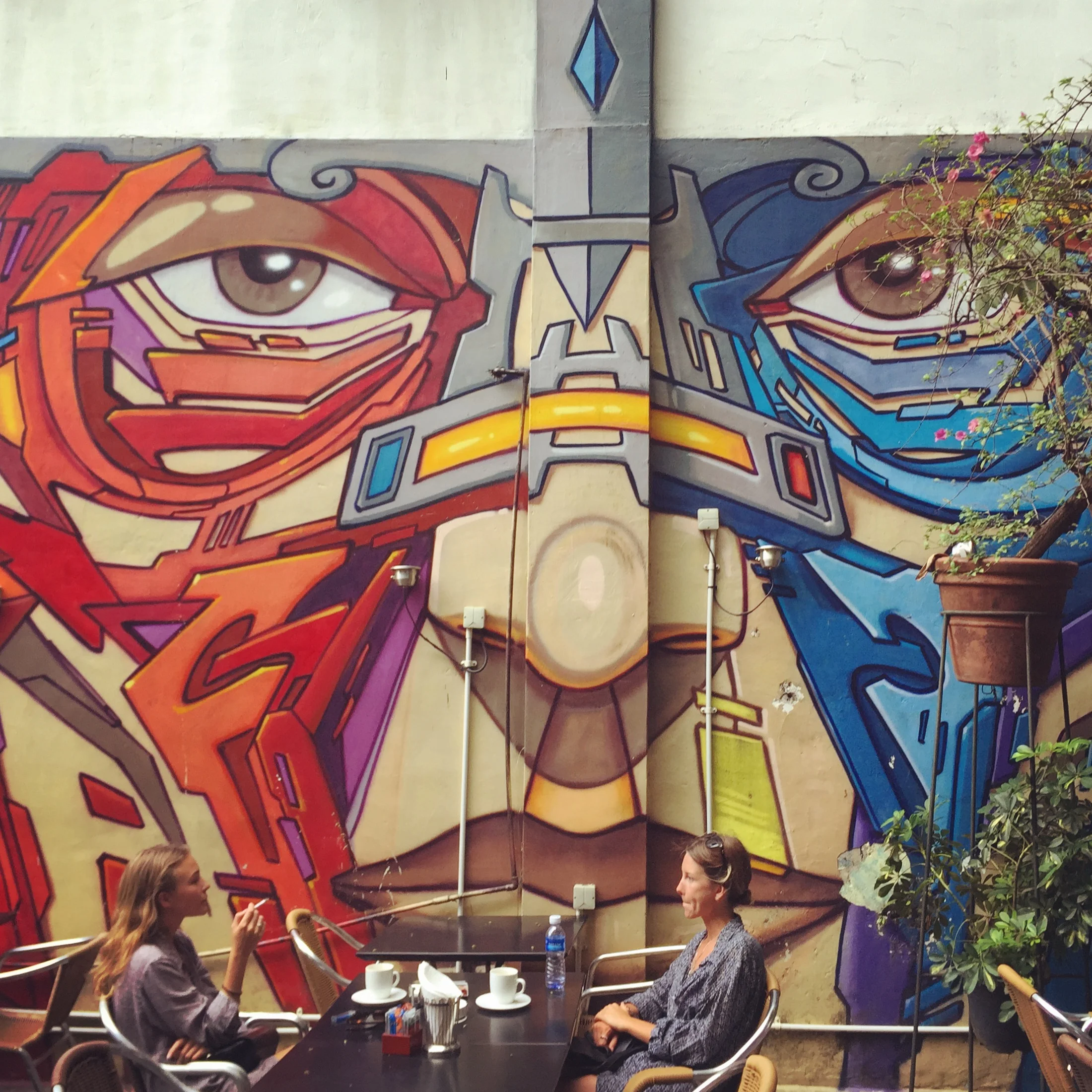The Tuol Sleng Museum is located in an old high school. That's because when the Khmer Rouge marched into Phnom Penh on April 17, 1975, they swiftly converted the high school into a detention center that would come to symbolize many of the great horrors that took place during the Khmer Rouge's reign until the Vietnamese invaded in January 1979. So that when you enter the compound, the first thing that strikes you is not the grim horrors that took place, but wondering what it must have been like to attend high school in Phnom Penh during peaceful times, picturing teenagers coming in and out of the shuttered classroom doors carrying books and lunches and hopes and dreams.
But as you move from room to room, you realize how quickly things can turn on a dime, how one wooden desk can be quickly transformed into a work station for an interrogator, and how all the other furniture can be removed to make way for torture facilities and imprisonment. It is, after all, just a building.
One of the things the Khmer Rouge did when they came to power was to ban (and kill) anything and everything that stood in the way of the implementation of their ideology. They abolished money, free markets, normal schooling, private property, foreign clothing styles, religious practices, traditional Khmer culture; there was no public or private transportation, no private property, and no non-revolutionary entertainment. What purpose would a high school serve, anyway, if the new order of business is to evacuate all city dwellers to rural areas to take on an ambitious plan to convert the entire nation of Kampuchea into an agrarian socialist "utopia."
Ultimately, this radical Maoist and Marxist-Leninist transformation program would fail. But not first before claiming the lives of some 1.7 million people who died through execution, starvation, famine, disease and exhaustion. Some of those 1.7 million people passed through the S-21 Detention Center (the former high school that's now called the Tuol Sleng Genocide Museum), about 14,000 - 17,000. Only 12 survived.
The first rooms you get to see belonged to the "VIPs": members of the Lon Nol army and existing government who had been in charge when the Khmer Rouge took over. After intense interrogations that involved severe physical torture, they would either be shipped off to the Killing Fields of Choeung Ek or executed on the premises. Each VIP prisoner was confined to a bed with their ankles shackled to the metal frame (lesser prisoners were stuffed into small cells, several to a room). When the Vietnamese eventually invaded in 1979, in response to a series of clashes between Cambodia and Vietnam, mostly due to border disputes, they found the last of the Khmer Rouge's victims lying dead. They (thankfully) photographed the horror; bodies had been hacked to death (legs and arms cut off), bludgeoned to death, forced to drink acid, and one man's face had been cut off and stomach cut out, with organs harvested presumably to eat (considered to be a way to get strength) and/or shipped to China to be turned into medicine.
As you continue through the museum, you encounter room after room of photographs of prisoners who met their fate at S-21. Numbers adhered to their black uniforms repeat; after a prisoner was executed, they'd simply reuse the number. Grim details emerge as you continue: barricades were put on the top floor of the building to prevent women from committing suicide (the only female bathroom was on the top floor) -- many of them preferring to end their lives than to deal with the rape and assault from the guards. Most prisoners were tortured (nails removed, ears cut off) to confess to crimes they'd never committed, such as being a member of the CIA or KGB. If you were a member of the educated (doctors, scholars, engineers), forget it. You would be executed, as would every member of your family. Wear glasses? You might be educated. Speak a foreign language? You might be educated. You can see where this is going.
As you move out of the city to the Killing Fields of Choeung Ek, it's hard to imagine that this peaceful little plot of land, a former orchard and Chinese cemetary, with the birds chirping and butterflies dancing in the breeze, was the site of so much tremendous horror. About 100 people were killed every day from 1975 - 1979, most of them arriving from S-21. To save on bullets, many were simply bludgeoned to death, or had their throats slit with the rough blade of a bamboo stalk, or, if that didn't do the trick, finally died when submerged in DDT poured over the masses to help contain the stench. (It makes the Nazis seem almost humane by using gas chambers -- or at the very least ruthlessly efficient.) There's a tree that was used to bash the heads of babies and children -- after which their mothers would be executed too. And another tree, from which the Khmer Rouge hung a speaker to drone out the sounds of screams and wails coming from the people as they lay dying. And all around you, slightly poking out of the earth, are the bones of the victims lying in shallow mass graves. When a bone is finally unearthed (usually during the rainy season), it's cleaned and put into a case with others as a reminder about the atrocities that took place here.
Rising out of the Killing Fields there is a beautiful stupa in memorium: it contains the skulls of 8,000 victims who died there, all stacked on shelves rising up towards the sky, with stickers identifying the manner of execution of each human head.
In high school, I took a class called Ideology & Revolution, in which we studied the major revolutions of the past few hundred years and the ideologies that supported and encouraged them. The conclusion was pretty much the same as my takeaway today at the Tuol Sleng Genocide Museum and the Killing Fields: if the ideology you adhere to doesn't hold the sanctity of human life in the highest regard, you're in trouble. Especially because in all the major genocides of the past hundred years, the revolutionaries have almost always used the logic that the ends justify the means. What is killing off millions of people if it means purging society of the inherent "ills" that are standing between you and perfection?
"If only it were so simple! If only there were evil people somewhere insidiously committing evil deeds, and it were necessary only to separate them from the rest of us and destroy them. But the line dividing good and evil cuts through the heart of every human being. And who is willing to destroy a piece of his own heart?" Aleksander Solzhenitsyn, The Gulag Archipelago, 1918-1956
As I walked around in silence throughout the former S-21 detention center and the Killing Fields, I couldn't help but think of the various crimes against humanity that have been carried out in the name of ideological fervour. Nazi Germany, obviously. Stalin. Bosnia. Rwanda. And while it is not yet classified as a genocide per se, the continued terror attacks by groups like ISIS and Boko Haram and other terrorist Islamic groups, carrying out barbaric murders against non-believers (the 'other') in the name of religious ideology. What I find so frightening about the actions and thinking behind ISIS et al is that it echoes and patterns the same ideological structure as these other groups, from the crude grouping of the world into "us vs. them," to dehumanizing the enemy so that murder comes easily and without remorse, to the flawed thinking that if only the world stepped in line to one set of rules, all problems would vanish and life would be perfect. Like the Solzhenitsyn quote articulates, most observers of humanity see that all men are capable of good and evil, and are all inherently flawed. No system, religious or otherwise, is going to be able to 'fix' something that lies so deeply at the core of human nature.
But there is hope. One thing I learned today is that as the power eventually shifted out of the Khmer Rouge's hands, the ruling government did not bring all members of the Khmer Rouge to trial. Instead, it gave many of them jobs, or allowed them to find new occupations without recourse. This was done to break the cycle of retribution and as a way to stop the resistance movement. It meant members could come forward and reenter society without defending themselves violently while hiding in the Cambodian jungles. It means that many families have not gotten the justice they probably deserve. But it has meant peace in Cambodia.
And today, as the Tuol Sleng Genocide Museum welcomes visitors to wander its hallways and confront this very dark time in Cambodian -- and world -- history, I'd like to think this old high school has resumed a purpose for learning once again. Instead of teaching math or English or science, it's a center for learning about the great tragedies that occur when the achievement of an ideology is placed above the most precious thing any of us have: our life.
"Blessed are the peacemakers, for they will be called children of God." -- Matthew 5:4



